Top Rankings
Regional School District 13 ranks among the top 20% of public school district in Connecticut for:
Category
Attribute
Science Proficiency
Highest science proficiency (Top 20%)
Graduation Rate
Highest graduation rate (Top 20%)
Student Attention
Lowest student:teacher ratio (Top 1%)
For the 2025 school year, there are 2 public preschools serving 404 students in Regional School District 13. This district's average pre testing ranking is 6/10, which is in the top 50% of public pre schools in Connecticut.
Public Preschools in Regional School District 13 have an average math proficiency score of 47% (versus the Connecticut public pre school average of 35%), and reading proficiency score of 57% (versus the 42% statewide average).
Minority enrollment is 11% of the student body (majority Hispanic), which is less than the Connecticut public preschool average of 59% (majority Hispanic).
Overview
This School District
This State (CT)
# Schools
5 Schools
345 Schools
# Students
1,318 Students
132,954 Students
# Teachers
127 Teachers
10,546 Teachers
Student : Teacher Ratio
10:1
10:1
District Rank
Regional School District 13, which is ranked within the top 50% of all 197 school districts in Connecticut (based off of combined math and reading proficiency testing data) for the 2021-2022 school year.
The school district's graduation rate of 95% has stayed relatively flat over five school years.
Overall District Rank
#87 out of 200 school districts
(Top 50%)
(Top 50%)
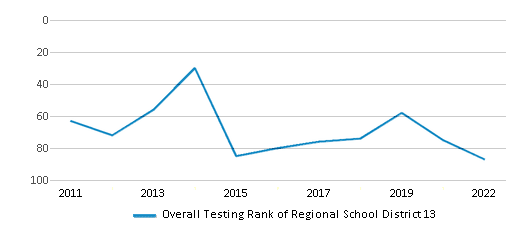
Math Test Scores (% Proficient)
46%
40%
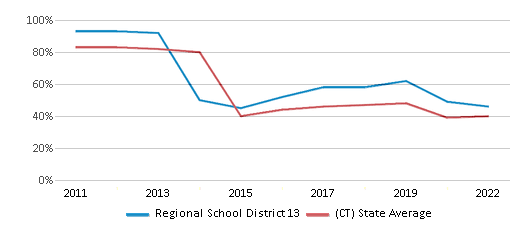
Reading/Language Arts Test Scores (% Proficient)
63%
50%
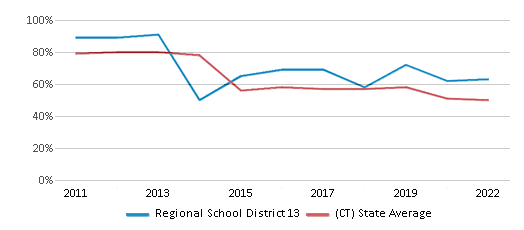
Science Test Scores (% Proficient)
69%
47%
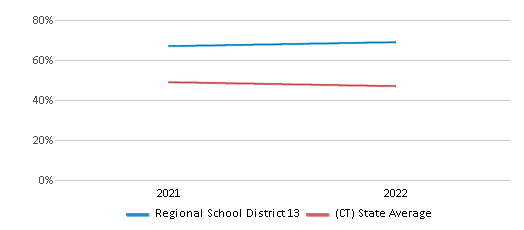
Graduation Rate
≥95%
89%
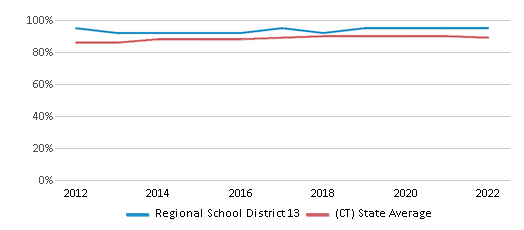
Students by Ethnicity:
Diversity Score
0.23
0.70
# American Indian Students
2 Students
381 Students
% American Indian Students
n/a
n/a
# Asian Students
18 Students
6,332 Students
% Asian Students
1%
5%
# Hispanic Students
99 Students
44,965 Students
% Hispanic Students
8%
34%
# Black Students
6 Students
19,832 Students
% Black Students
1%
15%
# White Students
1,151 Students
54,707 Students
% White Students
87%
41%
# Hawaiian Students
n/a
132 Students
% Hawaiian Students
n/a
n/a
# Two or more races Students
42 Students
6,568 Students
% of Two or more races Students
3%
5%
Students by Grade:
# Students in PK Grade:
25
14,518
# Students in K Grade:
94
19,819
# Students in 1st Grade:
106
19,906
# Students in 2nd Grade:
102
20,278
# Students in 3rd Grade:
102
15,997
# Students in 4th Grade:
104
16,056
# Students in 5th Grade:
116
13,209
# Students in 6th Grade:
98
5,100
# Students in 7th Grade:
108
3,978
# Students in 8th Grade:
104
3,865
# Students in 9th Grade:
90
67
# Students in 10th Grade:
79
64
# Students in 11th Grade:
105
43
# Students in 12th Grade:
85
54
# Ungraded Students:
-
-
District Revenue and Spending
The revenue/student of $33,550 is higher than the state median of $26,157. The school district revenue/student has grown by 7% over four school years.
The school district's spending/student of $32,657 is higher than the state median of $25,225. The school district spending/student has grown by 7% over four school years.
Total Revenue
$44 MM
$12,920 MM
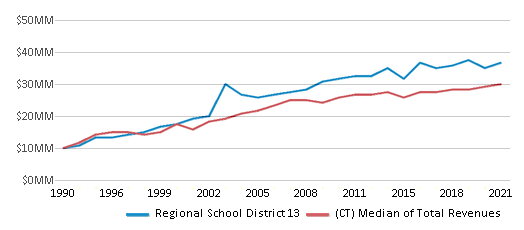
Spending
$43 MM
$12,459 MM

Revenue / Student
$33,550
$26,157
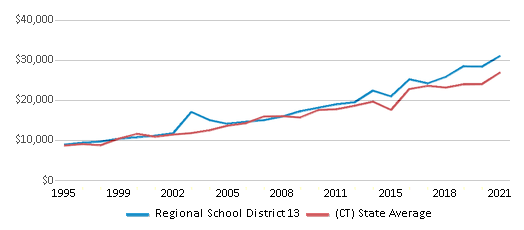
Spending / Student
$32,657
$25,225
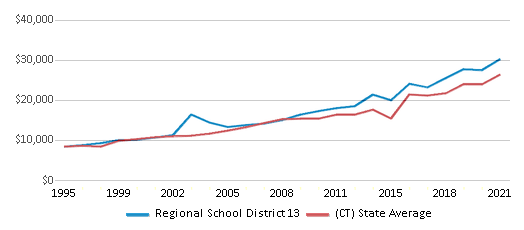
Best Regional School District 13 Public Preschools (2025)
School
(Math and Reading Proficiency)
(Math and Reading Proficiency)
Location
Grades
Students
Rank: #11.
John Lyman School
(Math: 45-49% | Reading: 55-59%)
Rank:
Rank:
6/
Top 50%10
106 Way Rd.
Middlefield, CT 06455
(860) 349-7240
Middlefield, CT 06455
(860) 349-7240
Grades: PK-4
| 174 students
Rank: #22.
Frederick Brewster School
(Math: 50-59% | Reading: 50-59% )
Rank:
Rank:
5/
Bottom 50%10
126 Tuttle Rd.
Durham, CT 06422
(860) 349-7227
Durham, CT 06422
(860) 349-7227
Grades: PK-2
| 230 students
Recent Articles

Sexual Harassment at Age 6: The Tale of a First Grade Suspension
A six-year old in Aurora, Colorado, was suspended after singing an LMFAO song to a little girl in his class and reportedly “shaking his booty.” We look at the case and the sexual harassment problem in public schools today.

How Scaffolding Could Change the Way Your Child Learns
This article explores the concept of instructional scaffolding, a teaching method that enhances learning by breaking down complex tasks into manageable parts. It highlights how scaffolding supports students in developing critical thinking skills and becoming more independent learners. The article discusses the benefits of scaffolding, including improved engagement and reduced anxiety, and provides strategies for its implementation across various educational levels.

February 05, 2025
Understanding the U.S. Department of Education: Structure, Impact, and EvolutionWe explore how the Department of Education shapes American education, from its cabinet-level leadership to its impact on millions of students, written for general audiences seeking clarity on this vital institution.





